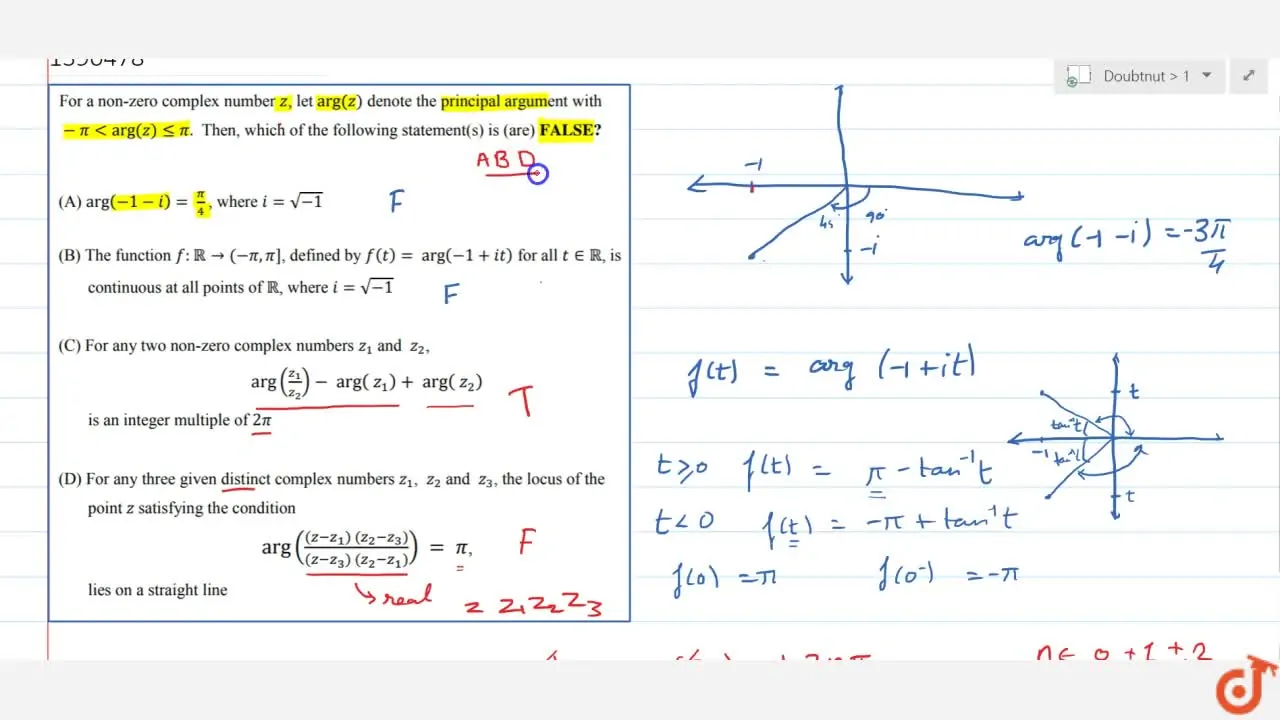For a non-zero complex number z , let arg(z) denote the principal argument with π<arg(z)≤π Then, which of the following statement(s) is (are) FALSE? arg(−1,−i)=π4, where i=√−1 (b) The function f:R→(−π,π], defined by f(t)=arg(−1+it) for all t∈R , is continuous at all points of R , where i=√−1 (c) For any two non-zero complex numbers z1 and z2 , arg(z1z2)−arg(z1)+arg(z2) is an integer multiple of 2π (d) For any three given distinct complex numbers z1 , z2 and z3 , the locus of the point z satisfying the condition arg((z−z1)(z2−z3)(z−z3)(z2−z1))=π , lies on a straight line
arg(−1−i)=π4, where i=√−1
The functionf:R→(−π,π], defined by f(t)=arg(−1+it) for all t∈R, is continous at all points of R, where i=√−1
For any tow non-zero complex number z1 and z2,arg(z1z2−arg(z1)+arg(z2) is an integer multiple of 2π
For any three given distinct complex numbers z1,z2andz3 the locus of the point z satisfying the condition ((z−z1)(z2−z3)(z−z3)(z2−z1))=π, lies on a strainght line.
The correct Answer is:A, B, D
(1) Comple number -1- I lies in thrid quadrant
∴arg(−1−i)=−3π4
(2) We have f:R→(−π,π],f(t)=arg(−1+it) for all t∈R
Complex number −1+it lies in second quadrant if t>0 and in third quadrant if t<0.
f(t)=arg(−1+it)
⎧⎪⎨⎪⎩π−tan−1∣∣t−1∣∣t≥0−(π−tan−∣∣t−1∣∣)t<0
{π−tan−1tt≥0−π+tan−1tt≤0
Clearly f(x) is discountinous at = 0.
(3) arg(z1z2)−arg(z1)+arg(z2)
=arg(z1)−argz2+2nπ−argz1+argz2=2nπ,n∈I
(4) arg((z−z1)(z2−z3)(z−z3)(z2−z1))=π
⇒arg.z−z1z−z3+arg.z2−z3z2β−z1=π
when α and β are angles subtened by line segment joining z1 and z3 at z and z2 respectively.
So, we get the following figure.
 Thus, locus of z is a circle .
Thus, locus of z is a circle .
Related Playlists
- BOOK - CENGAGECHAPTER - COMPLEX NUMBERSEXERCISE - Question Bank30videos
COMPLEX NUMBERS
- BOOK - CENGAGECHAPTER - COMPLEX NUMBERSEXERCISE - JEE Main Previous Year11videos
COMPLEX NUMBERS
- BOOK - CENGAGECHAPTER - CIRCLESEXERCISE - Question Bank32videos
CIRCLES
- BOOK - CENGAGECHAPTER - CONIC SECTIONSEXERCISE - Solved Examples And Exercises91videos
CONIC SECTIONS
Similar Questions
If for complex numbers z1andz2,arg(z1)−arg(z2)=0 then |z1−z2| is equal to
View SolutionIf for complex numbers z1 and z2, arg z1−arg(z2)=0 then |z1−z2| is equal to
View SolutionIf z1 and z2 are two non- zero comlex numbers such that |z1+z2|=|z1|+|z2| then arg (z1)−arg(z2) is equal to
View SolutionThe complex number z satisfying the condition arg{z−1z+1}=π4 lies on
View SolutionIf z1 and z2 are two non-zero complex numbers such that |z1+z2|=|z1|+|z2|, then arg(z1)-arg(z2) is equal to
View SolutionIf z1andz2, are two non-zero complex numbers such tha |z1+z2|=|z1|+|z2| then arg(z1)−arg(z2) is equal to
View SolutionLet z be a complex number such that the principal value of argument, argz>0. Then arg z-arg(-z) is
View SolutionIf z1 and z2 are two non-zero complex number such that |z1z2|=2 and arg(z1)−arg(z2)=π2 ,then the value of 3iz1z2
View SolutionIf z ans w are two non-zero complex numbers such that |zw|=1 and arg (z) = arg (w) =π2,¯zw is equal to
View SolutionFind the complex number z if arg(z+1)=π6 and arg(z−1)=2π3
View Solution


